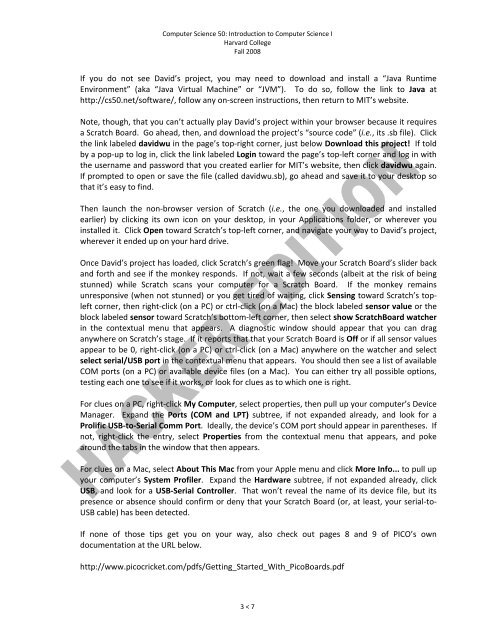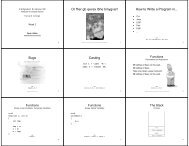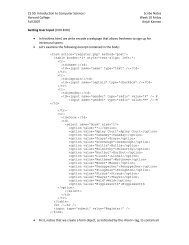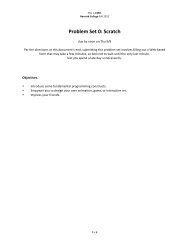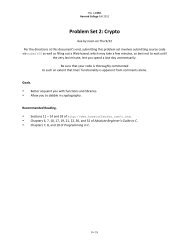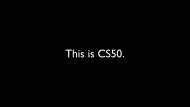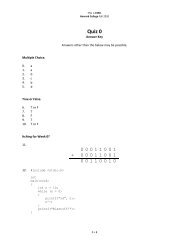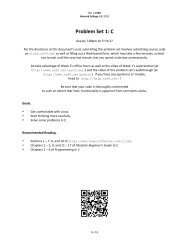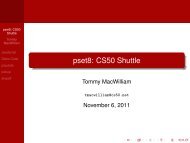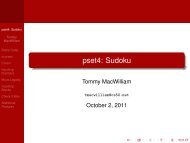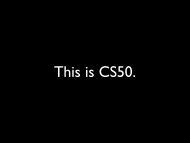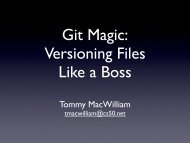Problem Set 0: Scratch
Problem Set 0: Scratch
Problem Set 0: Scratch
Create successful ePaper yourself
Turn your PDF publications into a flip-book with our unique Google optimized e-Paper software.
Computer Science 50: Introduction to Computer Science I<br />
Harvard College<br />
Fall 2008<br />
If you do not see David’s project, you may need to download and install a “Java Runtime<br />
Environment” (aka “Java Virtual Machine” or “JVM”). To do so, follow the link to Java at<br />
http://cs50.net/software/, follow any on-screen instructions, then return to MIT’s website.<br />
Note, though, that you can’t actually play David’s project within your browser because it requires<br />
a <strong>Scratch</strong> Board. Go ahead, then, and download the project’s “source code” (i.e., its .sb file). Click<br />
the link labeled davidwu in the page’s top-right corner, just below Download this project! If told<br />
by a pop-up to log in, click the link labeled Login toward the page’s top-left corner and log in with<br />
the username and password that you created earlier for MIT’s website, then click davidwu again.<br />
If prompted to open or save the file (called davidwu.sb), go ahead and save it to your desktop so<br />
that it’s easy to find.<br />
Then launch the non-browser version of <strong>Scratch</strong> (i.e., the one you downloaded and installed<br />
earlier) by clicking its own icon on your desktop, in your Applications folder, or wherever you<br />
installed it. Click Open toward <strong>Scratch</strong>’s top-left corner, and navigate your way to David’s project,<br />
wherever it ended up on your hard drive.<br />
Once David’s project has loaded, click <strong>Scratch</strong>’s green flag! Move your <strong>Scratch</strong> Board’s slider back<br />
and forth and see if the monkey responds. If not, wait a few seconds (albeit at the risk of being<br />
stunned) while <strong>Scratch</strong> scans your computer for a <strong>Scratch</strong> Board. If the monkey remains<br />
unresponsive (when not stunned) or you get tired of waiting, click Sensing toward <strong>Scratch</strong>’s topleft<br />
corner, then right-click (on a PC) or ctrl-click (on a Mac) the block labeled sensor value or the<br />
block labeled sensor toward <strong>Scratch</strong>’s bottom-left corner, then select show <strong>Scratch</strong>Board watcher<br />
in the contextual menu that appears. A diagnostic window should appear that you can drag<br />
anywhere on <strong>Scratch</strong>’s stage. If it reports that that your <strong>Scratch</strong> Board is Off or if all sensor values<br />
appear to be 0, right-click (on a PC) or ctrl-click (on a Mac) anywhere on the watcher and select<br />
select serial/USB port in the contextual menu that appears. You should then see a list of available<br />
COM ports (on a PC) or available device files (on a Mac). You can either try all possible options,<br />
testing each one to see if it works, or look for clues as to which one is right.<br />
For clues on a PC, right-click My Computer, select properties, then pull up your computer’s Device<br />
Manager. Expand the Ports (COM and LPT) subtree, if not expanded already, and look for a<br />
Prolific USB-to-Serial Comm Port. Ideally, the device’s COM port should appear in parentheses. If<br />
not, right-click the entry, select Properties from the contextual menu that appears, and poke<br />
around the tabs in the window that then appears.<br />
For clues on a Mac, select About This Mac from your Apple menu and click More Info... to pull up<br />
your computer’s System Profiler. Expand the Hardware subtree, if not expanded already, click<br />
USB, and look for a USB-Serial Controller. That won’t reveal the name of its device file, but its<br />
presence or absence should confirm or deny that your <strong>Scratch</strong> Board (or, at least, your serial-to-<br />
USB cable) has been detected.<br />
If none of those tips get you on your way, also check out pages 8 and 9 of PICO’s own<br />
documentation at the URL below.<br />
http://www.picocricket.com/pdfs/Getting_Started_With_PicoBoards.pdf<br />
3 < 7


